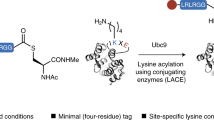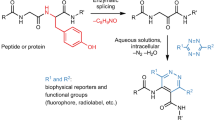Abstract
A protocol for selective and site-specific enzymatic labeling of proteins is described. The method exploits the protein co-/post-translational modification known as myristoylation, the transfer of myristic acid (a 14-carbon saturated fatty acid) to an N-terminal glycine catalyzed by the enzyme myristoyl-CoA:protein N-myristoyltransferase (NMT). Escherichia coli, having no endogenous NMT, is used for the coexpression of both the transferase and the target protein to be labeled, which participate in the in vivo N-terminal attachment of synthetically derived tagged analogs of myristic acid bearing a 'clickable' tag. This tag is a functional group that can undergo bio-orthogonal ligation via 'click' chemistry, for example, an azide, and can be used as a handle for further site-specific labeling in vitro. Here we provide protocols for in vivo N-terminal tagging of recombinant protein, and the synthesis and application of multifunctional reagents that enable protein labeling via click chemistry for affinity purification and detection by fluorescence. In addition to general N-terminal protein labeling, the protocol would be of particular use in providing evidence for native myristoylation of proteins of interest, proof of activity/selectivity of NMTs and cross-species reactivity of NMTs without resorting to the use of radioactive isotopes.
This is a preview of subscription content, access via your institution
Access options
Subscribe to this journal
Receive 12 print issues and online access
$259.00 per year
only $21.58 per issue
Buy this article
- Purchase on Springer Link
- Instant access to full article PDF
Prices may be subject to local taxes which are calculated during checkout






Similar content being viewed by others
References
Heal, W.P., Dang, T.H. & Tate, E.W. Activity-based probes: discovering new biology and new drug targets. Chem. Soc. Rev. 40, 246–257 (2011).
Heal, W.P. & Tate, E.W. Getting a chemical handle on protein post-translational modification. Org. Biomol. Chem. 8, 731–738 (2010).
Tate, E.W. Recent advances in chemical proteomics: exploring the post-translational proteome. J. Chem. Biol. 1, 17–26 (2008).
Saxon, E. & Bertozzi, C.R. Chemical and biological strategies for engineering cell surface glycosylation. Annu. Rev. Cell Dev. Biol. 17, 1–23 (2001).
Bertozzi, C.R. & Kiessling, L.L. Chemical glycobiology. Science 291, 2357–2364 (2001).
Saxon, E. & Bertozzi, C.R. Cell surface engineering by a modified Staudinger reaction. Science 287, 2007–2010 (2000).
Riz, I., Hawley, T.S. & Hawley, R.G. Lentiviral fluorescent protein expression vectors for biotinylation proteomics. Methods Mol. Biol. 699, 431–447 (2011).
de Boer, E. et al. Efficient biotinylation and single-step purification of tagged transcription factors in mammalian cells and transgenic mice. Proc. Natl. Acad. Sci. USA 100, 7480–7485 (2003).
Thyagarajan, A. & Ting, A.Y. Imaging activity-dependent regulation of neurexin-neuroligin interactions using trans-synaptic enzymatic biotinylation. Cell 143, 456–469 (2010).
Puthenveetil, S., Liu, D.S., White, K.A., Thompson, S. & Ting, A.Y. Yeast display evolution of a kinetically efficient 13-amino acid substrate for lipoic acid ligase. J. Am. Chem. Soc. 131, 16430–16438 (2009).
Berry, A.F. et al. Rapid multilabel detection of geranylgeranylated proteins by using bioorthogonal ligation chemistry. Chembiochem 11, 771–773 (2010).
Sprung, R. et al. Tagging-via-substrate strategy for probing O-GlcNAc modified proteins. J. Proteome Res. 4, 950–957 (2005).
Kho, Y. et al. A tagging-via-substrate technology for detection and proteomics of farnesylated proteins. Proc. Natl. Acad. Sci. USA 101, 12479–12484 (2004).
Heal, W.P. et al. Bioorthogonal chemical tagging of protein cholesterylation in living cells. Chem. Commun. 47, 4081–4083 (2011).
Lee, S.E. et al. Synthesis and reactivity of novel gamma-phosphate modified ATP analogues. Bioorg. Med. Chem. Lett. 19, 3804–3807 (2009).
Kwon, S.J., Choi, E.Y., Seo, J.B. & Park, O.K. Isolation of the Arabidopsis phosphoproteome using a biotin-tagging approach. Mol. Cells 24, 268–275 (2007).
Elphick, L.M., Lee, S.E., Gouverneur, V. & Mann, D.J. Using chemical genetics and ATP analogues to dissect protein kinase function. ACS Chem. Biol. 2, 299–314 (2007).
Alaimo, P.J., Shogren-Knaak, M.A. & Shokat, K.M. Chemical genetic approaches for the elucidation of signaling pathways. Curr. Opin. Chem. Biol. 5, 360–367 (2001).
Charron, G. et al. Robust fluorescent detection of protein fatty-acylation with chemical reporters. J. Am. Chem. Soc. 131, 4967–4975 (2009).
Kang, R. et al. Neural palmitoyl-proteomics reveals dynamic synaptic palmitoylation. Nature 456, 904–909 (2008).
Heal, W.P., Wickramasinghe, S.R., Leatherbarrow, R.J. & Tate, E.W. N-Myristoyl transferase-mediated protein labelling in vivo. Org. Biomol. Chem. 6, 2308–2315 (2008).
Heal, W.P. et al. Site-specific N-terminal labelling of proteins in vitro and in vivo using N-myristoyl transferase and bioorthogonal ligation chemistry. Chem. Commun. 4, 480–482 (2008).
Hang, H.C. et al. Chemical probes for the rapid detection of Fatty-acylated proteins in Mammalian cells. J. Am. Chem. Soc. 129, 2744–2745 (2007).
Roth, A.F. et al. Global analysis of protein palmitoylation in yeast. Cell 125, 1003–1013 (2006).
Martinez, A. et al. Extent of N-terminal modifications in cytosolic proteins from eukaryotes. Proteomics 8, 2809–2831 (2008).
Maurer-Stroh, S. & Eisenhaber, F. Myristoylation of viral and bacterial proteins. Trends Microbiol. 12, 178–185 (2004).
Price, H.P. et al. Myristoyl-CoA:protein N-myristoyltransferase, an essential enzyme and potential drug target in kinetoplastid parasites. J. Biol. Chem. 278, 7206–7214 (2003).
Wright, M.H., Heal, W.P., Mann, D.J. & Tate, E.W. Protein myristoylation in health and disease. J. Chem. Biol. 3, 19–35 (2009).
Moorhouse, A.D. & Moses, J.E. Click chemistry and medicinal chemistry: a case of 'cyclo-addiction'. ChemMedChem 3, 715–723 (2008).
Kolb, H.C., Finn, M.G. & Sharpless, K.B. Click chemistry: diverse chemical function from a few good reactions. Angew. Chem. Int. Ed. Engl. 40, 2004–2021 (2001).
Huisgen, R. 1,3-Dipolar Cycloadditions. Proc. Chem. Soc. 357–396 (1961).
Rostovtsev, V.V., Green, L.G., Fokin, V.V. & Sharpless, K.B. A stepwise huisgen cycloaddition process: copper(I)-catalyzed regioselective 'ligation' of azides and terminal alkynes. Angew. Chem. Int. Ed. Engl. 41, 2596–2599 (2002).
Tornoe, C.W., Christensen, C. & Meldal, M. Peptidotriazoles on solid phase: [1,2,3]-triazoles by regiospecific copper(I)-catalyzed 1,3-dipolar cycloadditions of terminal alkynes to azides. J. Org. Chem. 67, 3057–3064 (2002).
Kishore, N.S. et al. The substrate specificity of Saccharomyces cerevisiae myristoyl-CoA:protein N-myristoyltransferase. Analysis of myristic acid analogs containing oxygen, sulfur, double bonds, triple bonds, and/or an aromatic residue. J. Biol. Chem. 266, 8835–8855 (1991).
Heuckeroth, R.O. et al. Novel fatty acyl substrates for myristoyl-CoA:protein N-myristoyl- transferase. J. Lipid Res. 31, 1121–1129 (1990).
Rush, J.S. & Bertozzi, C.R. New aldehyde tag sequences identified by screening formylglycine generating enzymes in vitro and in vivo. J. Am. Chem. Soc. 130, 12240–12241 (2008).
Rangan, K.J., Yang, Y.Y., Charron, G. & Hang, H.C. Rapid visualization and large-scale profiling of bacterial lipoproteins with chemical reporters. J. Am. Chem. Soc. 132, 10628–10629 (2010).
Yang, Y.Y., Ascano, J.M. & Hang, H.C. Bioorthogonal chemical reporters for monitoring protein acetylation. J. Am. Chem. Soc. 132, 3640–3641 (2010).
Dang, T.H. et al. Chemical probes of surface layer biogenesis in Clostridium difficile. ACS Chem. Biol. 5, 279–285 (2010).
Towler, D.A., Gordon, J.I., Adams, S.P. & Glaser, L. The biology and enzymology of eukaryotic protein acylation. Annu. Rev. Biochem. 57, 69–99 (1988).
Sambrook, J. & Russell, D.W. The Condensed Protocols from Molecular Cloning: A Laboratory Manual (Cold Spring Harbor Laboratory Press, 2006).
Candiano, G. et al. Blue silver: a very sensitive colloidal Coomassie G-250 staining for proteome analysis. Electrophoresis 25, 1327–1333 (2004).
Bräse, S. & Banert, K. Organic Azides: Syntheses and Applications (John Wiley & Sons Ltd, 2010).
Acknowledgements
We are grateful to the UK Biotechnology and Biological Sciences Research Council (grant BB/D02014X/1 to E.W.T.), to the UK Engineering and Physical Sciences Research Council and the Imperial College Institute of Chemical Biology (PhD studentship to M.H.W.), and to Cancer Research UK (grant C29637/A 10711 to E.W.T.) for funding this work.
Author information
Authors and Affiliations
Contributions
W.P.H. conducted the initial syntheses; carried out the bacterial, click chemistry and SDS-PAGE/imaging work; and prepared the first draft of the manuscript and subsequent modifications. M.H.W. refined the design and synthesis of the trifunctional capture reagent and optimized the click chemistry conditions. E.T. refined the synthesis of and prepared the azido-myristate analog, and was also involved in manuscript preparation. E.W.T. supervised all of the work and oversaw preparation of the final version of the manuscript.
Corresponding author
Ethics declarations
Competing interests
The authors declare no competing financial interests.
Rights and permissions
About this article
Cite this article
Heal, W., Wright, M., Thinon, E. et al. Multifunctional protein labeling via enzymatic N-terminal tagging and elaboration by click chemistry. Nat Protoc 7, 105–117 (2012). https://doi.org/10.1038/nprot.2011.425
Published:
Issue Date:
DOI: https://doi.org/10.1038/nprot.2011.425
This article is cited by
-
Immobilization of azide-functionalized proteins to micro- and nanoparticles directly from cell lysate
Microchimica Acta (2024)
-
Monitoring cell membrane recycling dynamics of proteins using whole-cell fluorescence recovery after photobleaching of pH-sensitive genetic tags
Nature Protocols (2022)
-
Proteome-wide analysis of protein lipidation using chemical probes: in-gel fluorescence visualization, identification and quantification of N-myristoylation, N- and S-acylation, O-cholesterylation, S-farnesylation and S-geranylgeranylation
Nature Protocols (2021)
-
Targeting the N terminus for site-selective protein modification
Nature Chemical Biology (2017)
-
Nonradioactive quantification of autophagic protein degradation with L-azidohomoalanine labeling
Nature Protocols (2017)
Comments
By submitting a comment you agree to abide by our Terms and Community Guidelines. If you find something abusive or that does not comply with our terms or guidelines please flag it as inappropriate.



